Key takeaways:
- Anti-war activism fosters emotional connections, reminding participants that behind every statistic are real human lives and stories.
- Historical context of protests illustrates their power to influence societal change and highlights the importance of community resilience.
- Effective protests require clear messaging, coalition-building, and creative engagement to resonate with a broader audience.
- Participating in protests strengthens personal commitment to activism, emphasizing the interconnectedness of struggles across generations.
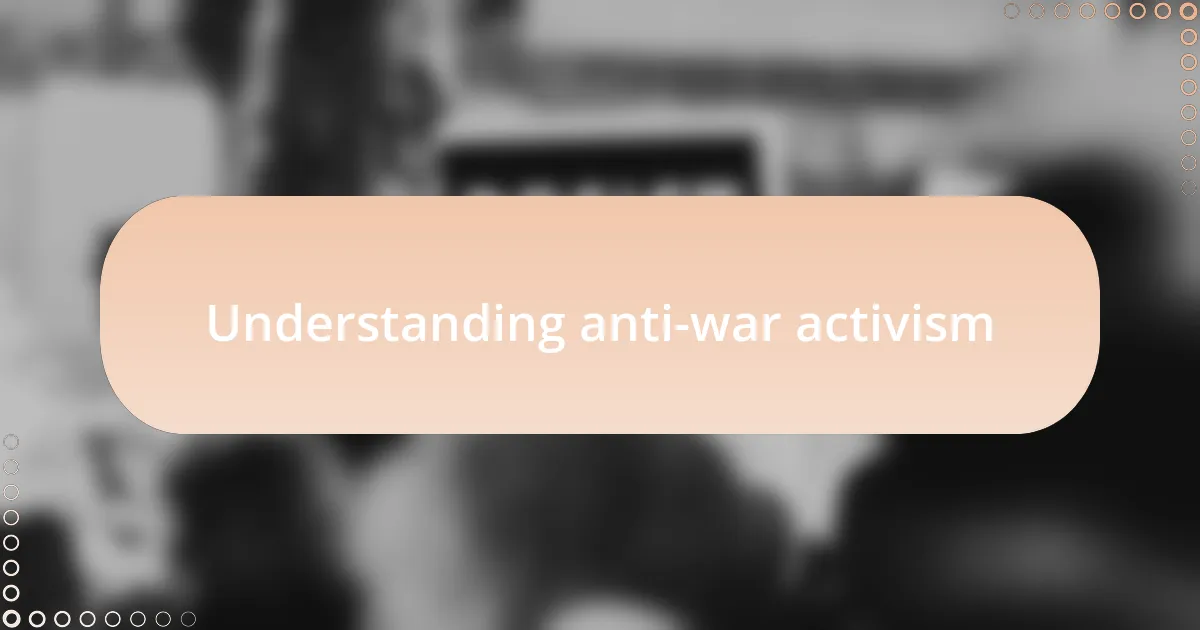
Understanding anti-war activism
Anti-war activism is a deeply personal and often transformative experience for many involved. For me, attending protests illuminated the sheer power of collective voices united against war. I remember feeling an overwhelming sense of hope when I stood shoulder to shoulder with hundreds of strangers, each of us fueled by a shared desire for peace. How often do we allow ourselves to feel the weight of our collective responsibility towards humanity?
At its core, anti-war activism challenges us to question our values and beliefs about conflict. I recall a moment during a protest when a young woman passionately shared her story of losing a loved one to war. Her tears and conviction struck a chord in me, reminding me that behind every statistic is a human life, a story, a dream unfulfilled. This emotional connection made me realize that activism isn’t just about opposing war; it’s about advocating for the lives and futures we often overlook.
Understanding anti-war activism also involves recognizing its historical roots and evolution. I’ve read accounts of past movements that shaped societal attitudes, and I can’t help but wonder: what lessons can we apply today? Engaging with history allows us to see the ongoing fight for peace as part of a larger narrative. It invites us to become active participants in this critical dialogue about our society’s future, emphasizing that our voices matter now more than ever.
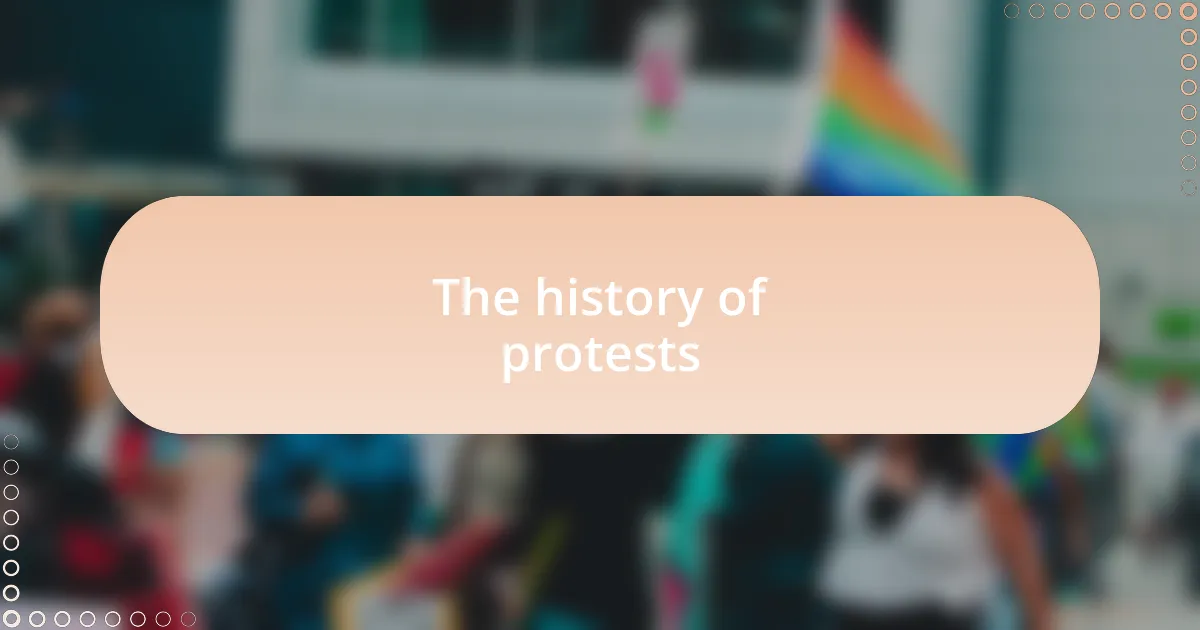
The history of protests
Protests have historically served as a catalyst for social change, rooted in a rich tapestry of collective action that stretches back centuries. I find it fascinating to trace the lineage of protest movements; each one tells a story of struggle and resilience. For instance, the anti-Vietnam War protests of the 1960s galvanized public opinion and highlighted how dissent could alter the course of policy decisions.
As I reflect on the civil rights movements, it strikes me how protests were not solely about raising voices but also about reclaiming dignity. I remember hearing stories from activists of that era, who faced relentless opposition, yet persisted with unyielding courage. Their experiences resonate deeply, illustrating that protests often reveal the strength of community in the face of adversity.
Moreover, the evolution of protests reveals changing societal values and priorities. I often wonder how the powerful impact of the 2017 Women’s March on Washington rippled worldwide, showcasing solidarity among diverse groups. This moment felt different; it brought people together to demand justice, promoting the idea that peace and equality are interwoven. How can we not feel inspired by that collective strength when we see it unfold?
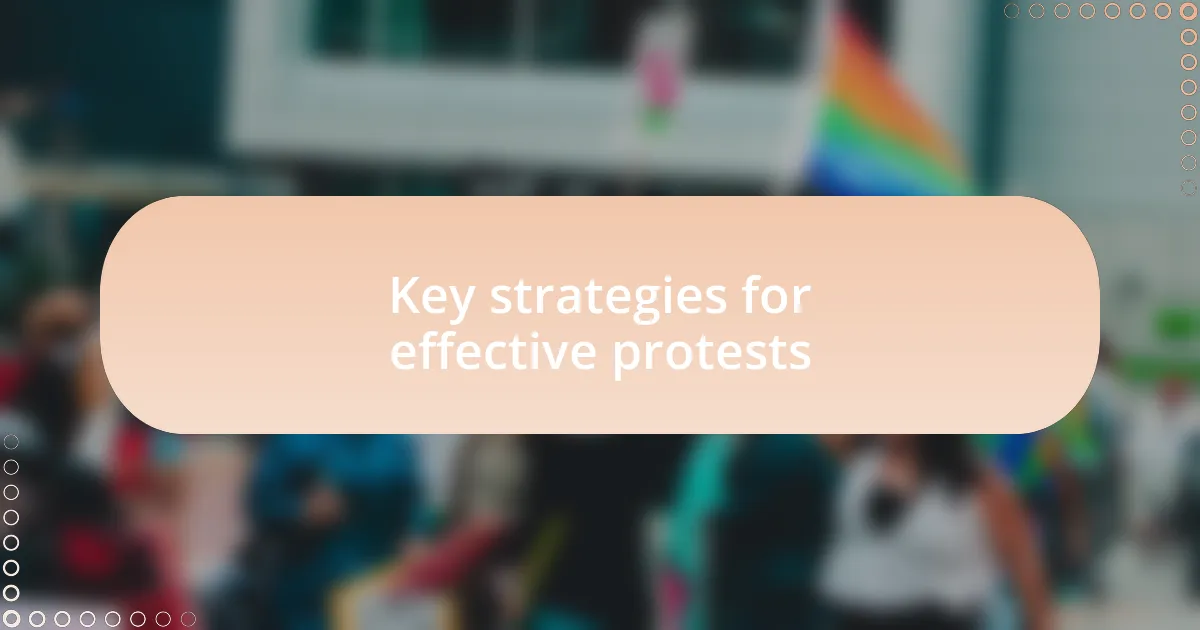
Key strategies for effective protests
One key strategy for effective protests is ensuring clarity in messaging. I’ve found that when the purpose of a protest is communicated clearly, it resonates more profoundly with people. For instance, when I participated in a local anti-war demonstration, having a straightforward message like “War is not the answer” made it easy for both participants and onlookers to understand our cause and join in.
Building coalitions with other organizations can greatly increase a protest’s impact. I remember attending a rally where various groups came together, each bringing their unique perspectives and strengths. It struck me how powerful it was to see different communities united by a shared goal, amplifying our voices and attracting more media attention. Isn’t it incredible how solidarity can transform a single message into a thunderous collective call for change?
Engagement through art and creativity also enhances protests. When I saw a group use vibrant murals and catchy songs to convey their anti-war sentiments, it left a lasting impression on both participants and passersby. Art transcends words and can evoke emotions that traditional speeches sometimes miss. How can we deny the potency of creativity in enacting change?
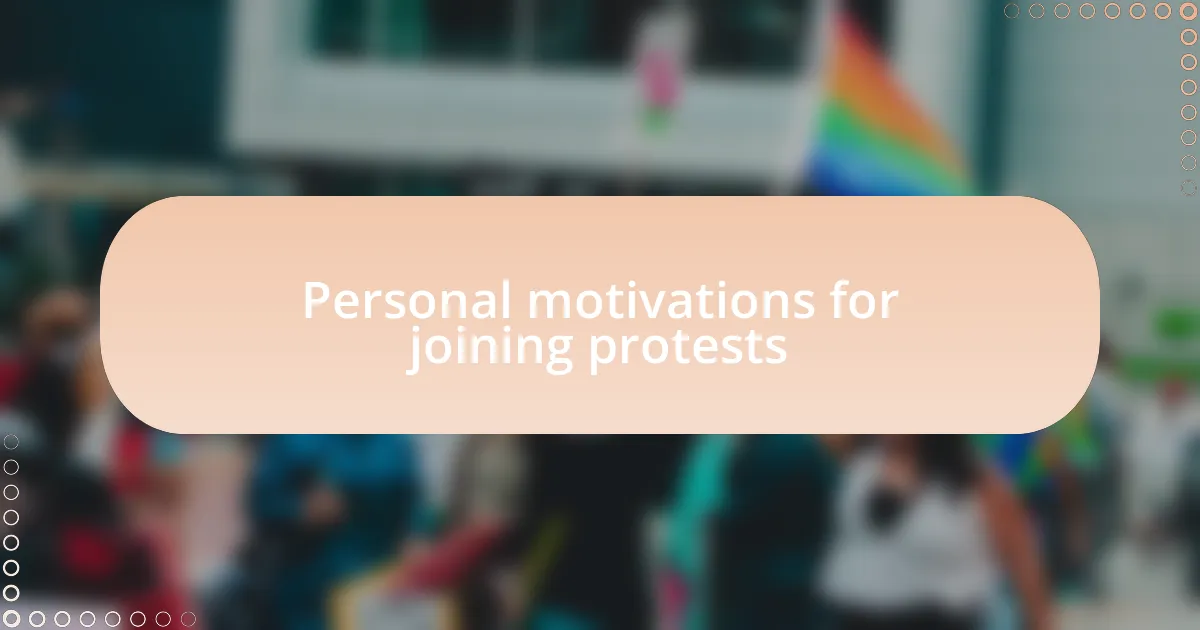
Personal motivations for joining protests
Participating in protests often stems from a deeply personal connection to the cause. For me, the motivation to join a recent anti-war rally was rooted in a sense of empathy; witnessing the devastation experienced by those affected by conflict ignited a fire within me. How could I stand by quietly when people were suffering due to decisions beyond their control? That emotional resonance pushed me to take action.
Another significant motivation for me lies in the desire to voice my beliefs alongside others who share the same values. I remember standing in a crowd, chanting alongside strangers who quickly felt like friends, all united by our shared conviction. It was in that moment I realized that the collective energy of our voices could ignite hope and inspire change, creating a powerful atmosphere that I couldn’t experience standing alone.
Additionally, the sense of accountability I feel to future generations drives my involvement. Every protest I’ve attended reminds me that my actions today contribute to shaping the world my children and grandchildren will inherit. When I look around at the diverse faces of participants, I often wonder: are we paving the way for a more peaceful tomorrow? That thought not only fuels my passion but strengthens my commitment to activism and advocacy.
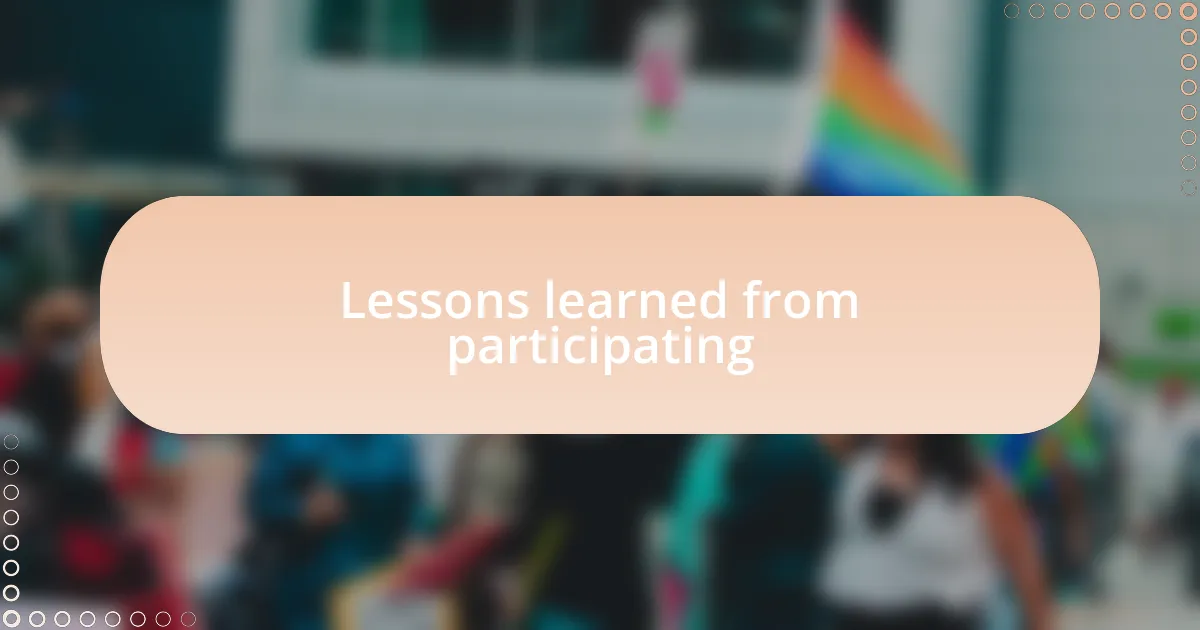
Lessons learned from participating
Participating in protests has taught me the incredible power of community. One particular moment stands out vividly in my mind: during a march, I locked eyes with an elderly veteran who was holding a sign that read “War Is Not the Answer.” The sadness in his eyes resonated with me deeply, reminding me that these issues affect all generations. It was a poignant reminder that our struggles are interconnected, and together, we can amplify our voices in a way that makes a real impact.
I’ve also learned that activism is not just about shouting slogans, but about listening and learning from others’ experiences. At one protest, I engaged in a heartfelt discussion with a young mother who shared her story of fleeing conflict. Her words struck a chord in me, opening my eyes to perspectives I had never considered. It reinforced my belief that to be a true ally, I must not only advocate but also take the time to understand the stories and struggles of those directly affected by war.
Lastly, every protest is a lesson in resilience. One time, despite facing rain and opposition, I stood steadfast beside my fellow activists. As the storm poured down, we held our ground, united in purpose. I realized then that our commitment cannot be easily shaken; it’s a testament to our belief in a better future. How many of us have felt this sense of unwavering dedication in the face of adversity? It’s a profound reminder that persistence is a powerful tool in the pursuit of justice.
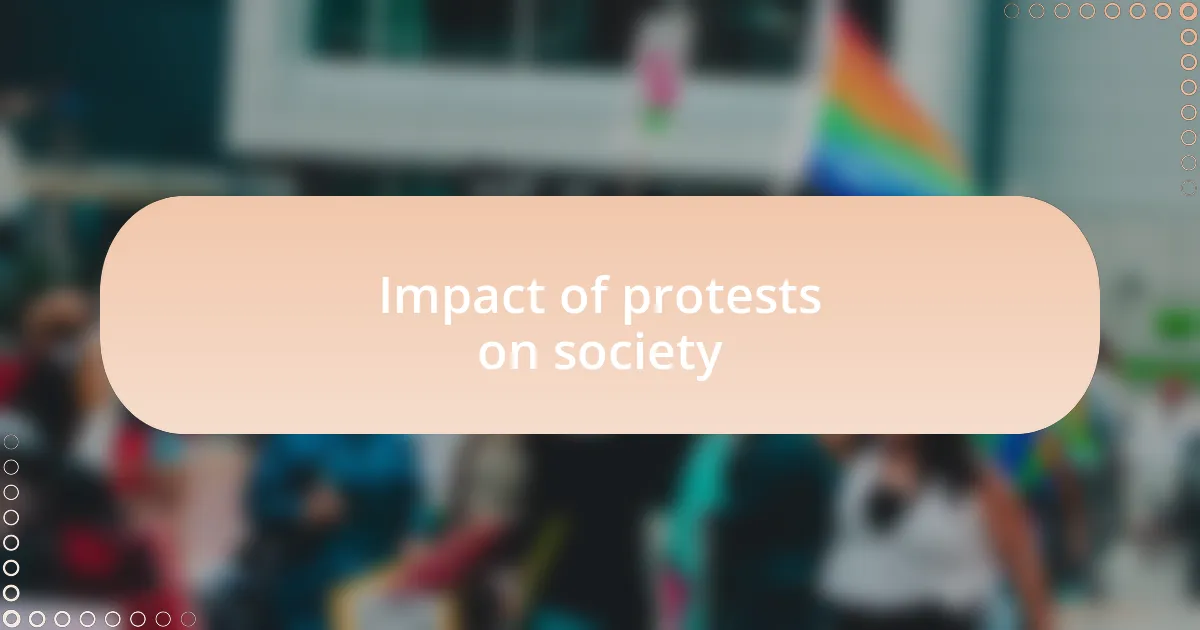
Impact of protests on society
The impact of protests on society is often underestimated. I remember standing shoulder to shoulder with strangers who quickly became friends. In that moment, our collective energy transformed into a force that could not be ignored. It was a stark reminder that when people unite, even the most entrenched systems can feel the tremors of change.
I’ve observed that protests can lead to meaningful dialogue. At an event, a group of protestors engaged with local lawmakers, and the atmosphere was electric with anticipation. This exchange was not just about demands but an opportunity for understanding. What struck me was the realization that conversations like these have the potential to shift policies and create lasting change. Isn’t it fascinating how a simple discussion can ripple through the fabric of society?
Furthermore, I’ve witnessed how protests can inspire others to join the movement. At one gathering, I saw a teenager holding a sign that read “My future matters.” It was a powerful moment that resonated deeply with everyone around. Sometimes, it takes just one courageous voice to encourage others to step forward. How many individuals are waiting for that spark to ignite their involvement? It’s a reminder that each protest holds the power to inspire a new generation of activists.
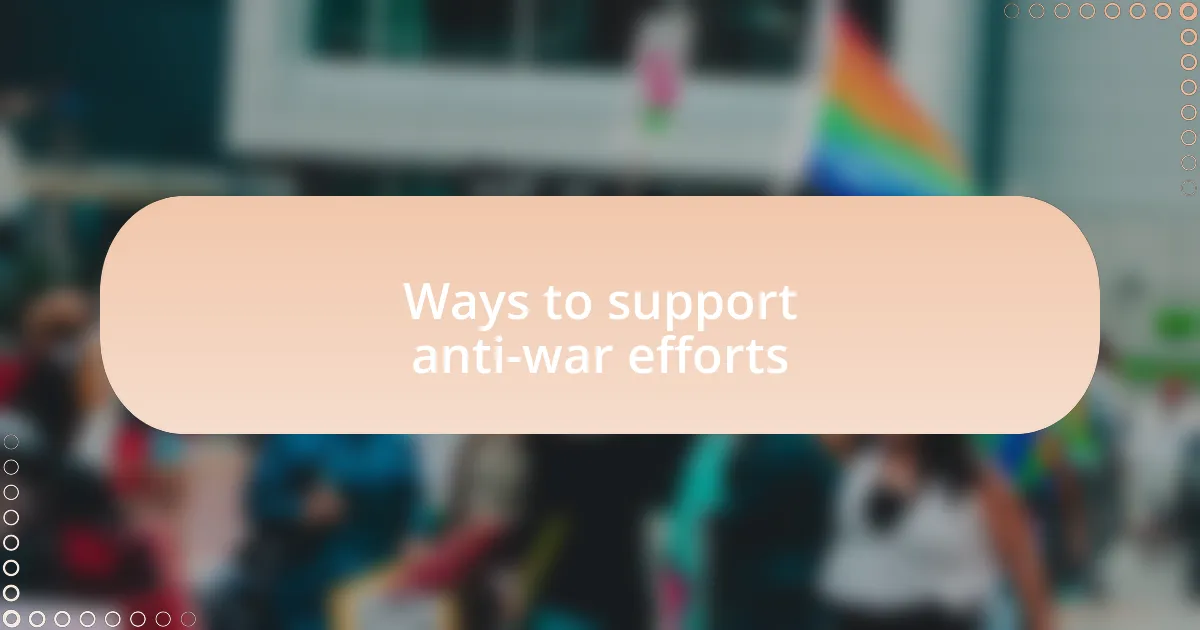
Ways to support anti-war efforts
Engaging with local organizations dedicated to anti-war efforts is a powerful way to make a difference. I remember a particular meeting where activists shared stories about their experiences and aspirations. The sense of community that developed was palpable, reminding me that collaboration strengthens our voices. Have you ever felt the energy of passionate discussions? It can really fuel your commitment to the cause.
Another effective strategy is to participate in or host educational events. I once organized a workshop to discuss the impact of military spending on social services. The room was filled with people who were unaware of the connections, and by the end, we had sparked a serious conversation about reallocating funds. Moments like these not only inform but also empower individuals to advocate more effectively. Isn’t it rewarding to see understanding transforming into action?
Lastly, consider amplifying your support through social media. I’ve found that sharing articles, personal reflections, or even memes about anti-war activism can reach audiences beyond your immediate circle. One tweet I shared resonated with hundreds, leading to a local meetup. It made me realize how accessible activism can be; every share, every voice contributes to a larger symphony of dissent. How often do we underestimate the potential of a single tweet?